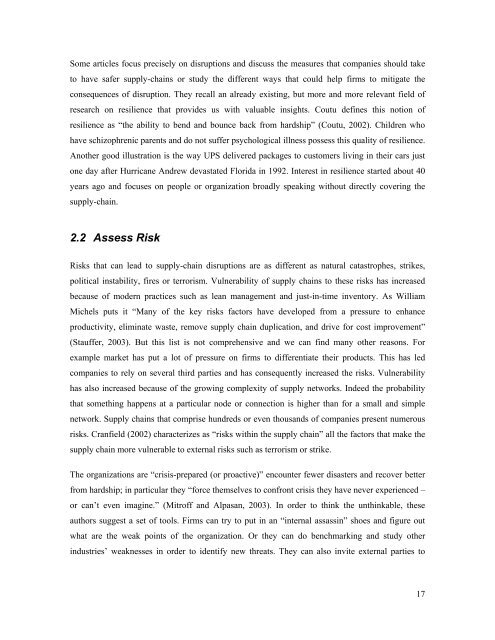Managing Risks of Supply-Chain Disruptions: Dual ... - CiteSeerX
Managing Risks of Supply-Chain Disruptions: Dual ... - CiteSeerX
Managing Risks of Supply-Chain Disruptions: Dual ... - CiteSeerX
Create successful ePaper yourself
Turn your PDF publications into a flip-book with our unique Google optimized e-Paper software.
Some articles focus precisely on disruptions and discuss the measures that companies should taketo have safer supply-chains or study the different ways that could help firms to mitigate theconsequences <strong>of</strong> disruption. They recall an already existing, but more and more relevant field <strong>of</strong>research on resilience that provides us with valuable insights. Coutu defines this notion <strong>of</strong>resilience as “the ability to bend and bounce back from hardship” (Coutu, 2002). Children whohave schizophrenic parents and do not suffer psychological illness possess this quality <strong>of</strong> resilience.Another good illustration is the way UPS delivered packages to customers living in their cars justone day after Hurricane Andrew devastated Florida in 1992. Interest in resilience started about 40years ago and focuses on people or organization broadly speaking without directly covering thesupply-chain.2.2 Assess Risk<strong>Risks</strong> that can lead to supply-chain disruptions are as different as natural catastrophes, strikes,political instability, fires or terrorism. Vulnerability <strong>of</strong> supply chains to these risks has increasedbecause <strong>of</strong> modern practices such as lean management and just-in-time inventory. As WilliamMichels puts it “Many <strong>of</strong> the key risks factors have developed from a pressure to enhanceproductivity, eliminate waste, remove supply chain duplication, and drive for cost improvement”(Stauffer, 2003). But this list is not comprehensive and we can find many other reasons. Forexample market has put a lot <strong>of</strong> pressure on firms to differentiate their products. This has ledcompanies to rely on several third parties and has consequently increased the risks. Vulnerabilityhas also increased because <strong>of</strong> the growing complexity <strong>of</strong> supply networks. Indeed the probabilitythat something happens at a particular node or connection is higher than for a small and simplenetwork. <strong>Supply</strong> chains that comprise hundreds or even thousands <strong>of</strong> companies present numerousrisks. Cranfield (2002) characterizes as “risks within the supply chain” all the factors that make thesupply chain more vulnerable to external risks such as terrorism or strike.The organizations are “crisis-prepared (or proactive)” encounter fewer disasters and recover betterfrom hardship; in particular they “force themselves to confront crisis they have never experienced –or can’t even imagine.” (Mitr<strong>of</strong>f and Alpasan, 2003). In order to think the unthinkable, theseauthors suggest a set <strong>of</strong> tools. Firms can try to put in an “internal assassin” shoes and figure outwhat are the weak points <strong>of</strong> the organization. Or they can do benchmarking and study otherindustries’ weaknesses in order to identify new threats. They can also invite external parties to17
















